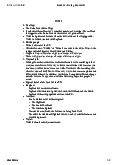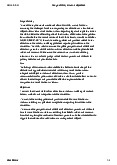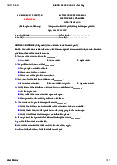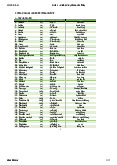

Preview text:
23:24 6/9/24
Eco 101 - tài liệu dành cho sinh viên
After poring over this video, we will have a very important understanding of how the
economy is working. From there, you will gain valuable experience in your career
development journey. Economies operate like a simple machine. But many people don't
understand it or they disagree with how it works. And this leads to economic necessity.
And Mr. Ray Dalio will share a simple but realistic explanation of the economy. It has
helped him predict and avoid global financial crises and it has worked for him for over 30
years. The economy seems to be very complicated and complicated, but in reality it
operates in a simple and mechanical way. It is made up of simple parts and many simple
transactions that are repeated many times. These transactions are driven by human
nature and they create three main forces that drive the economy. First comes
productivity growth, then the short-term debt cycle, and finally the long-term debt
cycle. He looks at these three main forces and how they interact, creating a good model
for tracking the economy and understanding what's happening right now. Let's start with
the simplest component of the economy. About transactions - an economy is simply the
sum total of the transactions that make up it, and trading is a very simple concept. You
can make transactions anytime, anywhere. Every time you buy something, you create a
transaction. A transaction that involves a buyer exchanging money or credit with a seller
for goods, services, or financial assets (investments: stocks, debit notes, etc.) Credit is
also used. to spend like money, so when we add up the amount and the number of
credits spent, we get the total amount spent. Total spending drives the economy. If you
divide the amount spent by the quantity sold, you get the price. And that's a transaction.
Those are the foundations of economic engines. All cycles and all forces in the economy
are driven by transactions. So if we understand transactions, we can understand how the
whole economy works. A market consisting of all buyers and all sellers making
transactions for the same thing,. For example, the noodle market, the car market, the
stock market, and millions of other markets. An economy consists of all transactions in
all its markets. If you calculate total spending and total goods and services sold in all
markets, you have everything you need to know to understand the economy. It's as
simple as that. All people, businesses, banks and governments participate in
transactions: the exchange of money, credit for services, goods and financial assets. The
biggest buyer and seller is the government, which includes two important agencies: the
central government that collects taxes and spends, and the central bank, which is
different from buyers and sellers because it controls the amount of money. money and
credit in the economy. It performs this function by adjusting interest rates and printing
more money. From the above reasons, we will see that the central bank is an important
player in the flow of credit. Mr. Ray Dalio wants us to pay attention to the credit factor.
Credit is a very important part of the economy and perhaps the least understood part. It about:blank 1/2 23:24 6/9/24
Eco 101 - tài liệu dành cho sinh viên
is important because it is the largest and most “volatile” part. Just as buyers and sellers
come to the marketplace to execute transactions, so do creditors and borrowers.. It
seems simple, but signals are a tricky concept because it has other names. As soon as
credit is created, it immediately turns into debt. Liabilities are both assets to borrowers
and liabilities of borrowers. Credit is important because when one day he borrows credit
he can increase his spending. And spending leads the economy. By because that is one
person's expenditure is another's income. Over the long term, productivity matters
most, but in the short term, signals play an important role. That is because many
energies are not variable so it does not drive variable economics. The evolution of the
change is not due to the job, how much software is released or the professionalism, but
mainly to the amount of credit in the economy. It's all about human nature and the way
credit works. In an economy with no signals, the only way to increase your spending is to
do more. as a result, an economy with signals is more granular and allows income to
grow faster than productivity in the short term. Credit isn't bad, it creates cycles. To
summarize, there are three rules that Mr. Ray DAlio wants to convey: First, don't let debt
grow faster than income because debt will crush you. Second: do not to enter the gain
fast over the power by because your last will be lost the feature. And lastly, do all you
can to build capacity because in the long run, what matters most. about:blank 2/2




